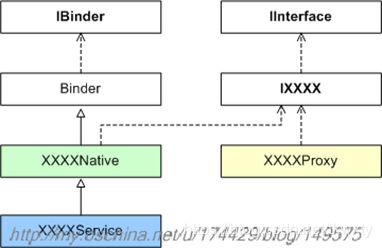Android Binder入门指南之Binder相关的接口和类
Android Binder入门指南之Binder相关的接口和类
前言
前面的篇章Android Binder机制(二) Binder中的数据结构对我们要攀登的Binder机制中将要牵涉到的数据结构(包括应用层的和内核层的)做了非常详细的讲解和阐述。本篇幅重点要突破的是Binder机制中相关的接口和类,我们知道Android的绝大部分跨进程通信机制都是基于Binder的,正所谓做戏得全套,Binder也不列外,这种机制不但会在底层C++的世界使用,也会在上层Java的世界使用,所以必须提供Java和C++两个层次的支持。当然这些Android的妈咪谷歌都为我们考虑到了。
在正式开始正文介绍前附上本篇相关代码的所在文件的路径。
frameworks/base/core/java/android/os/IBinder.java
frameworks/base/core/java/android/os/Binder.java
frameworks/base/core/java/android/os/IInterface.java
frameworks/native/include/binder/IBinder.h
frameworks/native/libs/binder/Binder.cpp
frameworks/native/include/binder/Binder.h
frameworks/native/include/binder/BpBinder.h
frameworks/native/libs/binder/BpBinder.cpp
system/core/include/utils/RefBase.h
frameworks/native/include/binder/IInterface.h
frameworks/native/include/binder/ProcessState.h
frameworks/native/libs/binder/ProcessState.cpp
frameworks/native/include/binder/IPCThreadState.h
frameworks/native/libs/binder/IPCThreadState.cpp
注意:本文是基于Android 7.1版本进行介绍的!
1. Java层次的Binder接口和类
Java层级Binder相关的接口和类并不是很多,因为Binder其实大部分的重头戏都是在C++层和内核层,常见的接口和类有IBinder接口、IInterface接口,Binder类,BinderProxy类等。
1.1 IBinder
Android要求所有的Binder实体都必须实现IBinder接口,其文件在Android源码的路径是frameworks/base/core/java/android/os/IBinder.java,该接口的定义截选如下:
public interface IBinder {
...
public String getInterfaceDescriptor() throws RemoteException;
public boolean pingBinder();
public boolean isBinderAlive();
public IInterface queryLocalInterface(String descriptor);
public void dump(FileDescriptor fd, String[] args) throws RemoteException;
public void dumpAsync(FileDescriptor fd, String[] args) throws RemoteException;
public void shellCommand(FileDescriptor in, FileDescriptor out, FileDescriptor err,
String[] args, ResultReceiver resultReceiver) throws RemoteException;
public boolean transact(int code, Parcel data, Parcel reply, int flags)
throws RemoteException;
public interface DeathRecipient {
public void binderDied();
}
public void linkToDeath(DeathRecipient recipient, int flags)
throws RemoteException;
public boolean unlinkToDeath(DeathRecipient recipient, int flags);
}
1.2 IInterface
IInterface接口比较简单,其源码路径为仅仅单单定义了一个方法,不管是服务端还是客户端都需要实现该接口
public interface IInterface {
IBinder asBinder();
}
1.3 BinderProxy
BinderProxy是IBinder的子类,客户端进程持有关联的服务的的BinderProxy对象从而完成相关的远程服务调用,其底层相对应的C++层的BpBinder后续会介绍。
final class BinderProxy implements IBinder {
public native boolean pingBinder();
public native boolean isBinderAlive();
public IInterface queryLocalInterface(String descriptor) {
return null;
}
public boolean transact(int code, Parcel data, Parcel reply, int flags) throws RemoteException {
Binder.checkParcel(this, code, data, "Unreasonably large binder buffer");
if (Binder.isTracingEnabled()) { Binder.getTransactionTracker().addTrace(); }
return transactNative(code, data, reply, flags);
}
public native String getInterfaceDescriptor() throws RemoteException;
public native boolean transactNative(int code, Parcel data, Parcel reply,
int flags) throws RemoteException;
...
}
1.4 Binder
Binder也是IBinder的子类,Java层提供服务的Server进程持有一个Binder对象从而完成跨进程间通信。
public class Binder implements IBinder {
public String getInterfaceDescriptor() {
return mDescriptor;
}
public IInterface queryLocalInterface(String descriptor) {
if (mDescriptor.equals(descriptor)) {
return mOwner;
}
return null;
}
protected boolean onTransact(int code, Parcel data, Parcel reply,
int flags) throws RemoteException {
...
}
public final boolean transact(int code, Parcel data, Parcel reply,
int flags) throws RemoteException {
if (false) Log.v("Binder", "Transact: " + code + " to " + this);
if (data != null) {
data.setDataPosition(0);
}
boolean r = onTransact(code, data, reply, flags);
if (reply != null) {
reply.setDataPosition(0);
}
return r;
}
}
Java层次中,与Binder相关的接口或类的继承关系如下:

在实际开发使用中,我们并不需要编写上图的XXXXNative、XXXXProxy,它们会由ADT根据我们编写的aidl脚本自动生成。但是最好能掌握手撕什么相关的类实现,这样对于更好的理解和掌握BInd非常有帮助的。用户只需继承XXXXNative编写一个具体的XXXXService即可,这个XXXXService就是远程通信的服务实体类,而XXXXProxy则是其对应的代理类。
关于Java层次的binder组件,我们就先说这么多,主要是先介绍一个大概。就研究跨进程通信而言,其实质内容基本上都在C++层次,Java层次只是一个壳而已。以后我会写专文来打通Java层次和C++层次,看看它们是如何通过JNI技术关联起来的。现在我们还是把注意力集中在C++层次吧。
2. C++层次的相关接口和类
在C++层次,就能看到各种关于Binder博客中经常反复肯定会被提到的BpBinder类和BBinder了,这两个类都继承于IBinder。当然还有IInterface,BpInterface,BnInterface,BpRefBase,ProcessState ,IPCThreadState ,下面我们来分别进行简单的介绍,在正式介绍前先奉上一关于上述几个接口和类之前的关系图,这就好比相亲之前得让介绍人先给个对方的照片,看过以后才能确定是否有进一步发展的空间不是!
2.1 IBinder
它定义在frameworks/native/include/binder/IBinder.h中。IBinder也是一个抽象出来的类,它包括了localBinder(), remoteBinder()和transact()等非常重要的接口。IBinder有两个直接子类类:BpBinder和BBinder。
class IBinder : public virtual RefBase
{
public:
...
IBinder();
virtual sp<IInterface> queryLocalInterface(const String16& descriptor);
virtual const String16& getInterfaceDescriptor() const = 0;
virtual bool isBinderAlive() const = 0;
virtual status_t pingBinder() = 0;
virtual status_t dump(int fd, const Vector<String16>& args) = 0;
static status_t shellCommand(const sp<IBinder>& target, int in, int out, int err,
Vector<String16>& args,
const sp<IResultReceiver>& resultReceiver);
virtual status_t transact( uint32_t code,
const Parcel& data,
Parcel* reply,
uint32_t flags = 0) = 0;
class DeathRecipient : public virtual RefBase
{
public:
virtual void binderDied(const wp<IBinder>& who) = 0;
};
virtual status_t linkToDeath(const sp<DeathRecipient>& recipient,
void* cookie = NULL,
uint32_t flags = 0) = 0;
virtual status_t unlinkToDeath( const wp<DeathRecipient>& recipient,
void* cookie = NULL,
uint32_t flags = 0,
wp<DeathRecipient>* outRecipient = NULL) = 0;
virtual bool checkSubclass(const void* subclassID) const;
typedef void (*object_cleanup_func)(const void* id, void* obj, void* cleanupCookie);
virtual void attachObject( const void* objectID,
void* object,
void* cleanupCookie,
object_cleanup_func func) = 0;
virtual void* findObject(const void* objectID) const = 0;
virtual void detachObject(const void* objectID) = 0;
virtual BBinder* localBinder();
virtual BpBinder* remoteBinder();
protected:
virtual ~IBinder();
private:
};
2.2 BpBinder和BBinder
BpBinder和BBinder是相互对应的,可以算是一对兄弟组合,下面分别来介绍一下:
(1). BpBinder:是Binder代理类。通过remoteBinder()可以获取BpBinder对象;而且,对于C++层而言,它相当于一个远程Binder。BpBinder的事务接口transact()会调用IPCThreadState的transact(),进而实现与Binder驱动的事务交互。此外,BpBinder中有一个mHandle句柄成员,它用来保存Server位于Binder驱动中的"Binder引用的描述"。句柄0是ServiceManager的句柄。
class BpBinder : public IBinder
{
public:
BpBinder(int32_t handle);
inline int32_t handle() const { return mHandle; }
...
virtual status_t transact( uint32_t code,
const Parcel& data,
Parcel* reply,
uint32_t flags = 0);
...
virtual BpBinder* remoteBinder();
private:
const int32_t mHandle;
...
}
(2).BBinder:是本地Binder。通过localBinder()可以获取BBinder对象。当Server收到请求之后,会调用BBinder的onTransact()函数进行处理。而不同的Server会重载onTransact()函数,从而可以根据各自的情况对事务进行处理。
class BBinder : public IBinder
{
public:
BBinder();
virtual const String16& getInterfaceDescriptor() const;
virtual bool isBinderAlive() const;
virtual status_t pingBinder();
...
virtual status_t transact( uint32_t code,
const Parcel& data,
Parcel* reply,
uint32_t flags = 0);
...
virtual BBinder* localBinder();
protected:
virtual ~BBinder();
virtual status_t onTransact( uint32_t code,
const Parcel& data,
Parcel* reply,
uint32_t flags = 0);
private:
BBinder(const BBinder& o);
...
};
2.3 RefBase和BpRefBase
如果说BpBinder和BBinder是兄弟组合,那么RefBase和BpRefBase就是父子组合了,下面分别就两位来一个全方位的展示:
(1).RefBase:它定义在system/core/include/utils/RefBase.h中。RefBase是一个公共父类,它声明了许多常用的接口。包括增加引用计数,获取引用计数,新增对象的弱引用等接口,其中比较重要的方法是onFirstRef(),在Android的Native世界里面你会惊奇的发现许多C++的初始化工作都是在onFirstRef()里面执行的,不信可以搜搜试试。
class RefBase
{
public:
void incStrong(const void* id) const;
void decStrong(const void* id) const;
void forceIncStrong(const void* id) const;
int32_t getStrongCount() const;
class weakref_type
{
public:
RefBase* refBase() const;
void incWeak(const void* id);
void decWeak(const void* id);
...
};
...
protected:
RefBase();
virtual ~RefBase();
...
virtual void onFirstRef();
...
};
(2).BpRefBase:它定义在frameworks/native/include/binder/Binder.h中。BpRefBase继承于RefBase,它有一个IBinder*类型的成员mRemote,同时提供了获取该mRemote的方法。实际上,该mRemote就是BpBinder对象。
class BpRefBase : public virtual RefBase
{
protected:
BpRefBase(const sp<IBinder>& o);
virtual ~BpRefBase();
virtual void onFirstRef();
virtual void onLastStrongRef(const void* id);
virtual bool onIncStrongAttempted(uint32_t flags, const void* id);
inline IBinder* remote() { return mRemote; }
inline IBinder* remote() const { return mRemote; }
private:
BpRefBase(const BpRefBase& o);
BpRefBase& operator=(const BpRefBase& o);
IBinder* const mRemote;//这就是那个很重要的mRemote
RefBase::weakref_type* mRefs;
std::atomic<int32_t> mState;
};
2.4 IInterface
它定义在frameworks/native/include/binder/IInterface.h中。和RefBase类似,它也是一个公共父类,IInterface中声明了asBinder()方法,用于获取对象的IBinder对象。
class IInterface : public virtual RefBase
{
public:
IInterface();
static sp<IBinder> asBinder(const IInterface*);
static sp<IBinder> asBinder(const sp<IInterface>&);
protected:
virtual ~IInterface();
virtual IBinder* onAsBinder() = 0;
};
2.5 BpInterface和BnInterface
(1).BpInterface:它定义在frameworks/native/include/binder/IInterface.h中。实际上,BpInterface是一个模板类,同时继承了BpRefBase和INTERFACE,这里的INTERFACE是模板。像IServiceManager,IMediaPlayerService等Server都是通过继承模板类是实现的,相关的代码如下:
template<typename INTERFACE>
class BpInterface : public INTERFACE, public BpRefBase
{
public:
BpInterface(const sp<IBinder>& remote);
protected:
virtual IBinder* onAsBinder();
};
(2).BnInterface:它定义在frameworks/native/include/binder/IInterface.h中。和BpInterface类似,BnInterface也是一个模板类,它同时继承了BBinder和INTERFACE。像BnServiceManager,BnMediaPlayerService等本地Server都是通过继承模板类是实现的,相关的代码如下:
template<typename INTERFACE>
class BnInterface : public INTERFACE, public BBinder
{
public:
virtual sp<IInterface> queryLocalInterface(const String16& _descriptor);
virtual const String16& getInterfaceDescriptor() const;
protected:
virtual IBinder* onAsBinder();
};
前面篇幅的章节一和章节二让我们对Java层和C++层的Binder有关的类有了一个比较清晰的认识,但是还是比较模糊是不,那么可以通过下面的示意图来一个清晰的整体概括,通过该示意图我们应该能大致上了解Java和C++层的Binder怎么关联起来了。

3.ProcessState
它的源码定义在它定义在frameworks/native/libs/binder/ProcessState.cpp中。对于开发Android app的读者来说,在Android上层架构中,谷歌妈咪已经很大幅度地弱化了进程的概念了。应用开发的小伙伴能看到的主要是四大组件的概念了,再也找不到以前熟悉的main()函数了。然而,底层程序(C++层次)毕竟还是得跑在一个个进程之上,现在我们就来看底层进程是如何运用Binder机制来完成跨进程通信的。
在每个进程中,会有一个全局的ProcessState对象。这个很容易理解,ProcessState的字面意思不就是“进程状态”吗,ProcessState的实例是采用单例模式实现的,我们截选其中的一部分重要的:
class ProcessState : public virtual RefBase
{
public:
static sp<ProcessState> self();
...
void startThreadPool();
...
void spawnPooledThread(bool isMain);
status_t setThreadPoolMaxThreadCount(size_t maxThreads);
private:
friend class IPCThreadState;
...
struct handle_entry
{
IBinder* binder;
RefBase::weakref_type* refs;
};
handle_entry* lookupHandleLocked(int32_t handle);
int mDriverFD;
void* mVMStart;
mutable Mutex mLock; // protects everything below.
Vector<handle_entry> mHandleToObject;
...
KeyedVector<String16, sp<IBinder> > mContexts;
...
};
它拥有两个非常重要的成员:mDriverFD和mHandleToObject,我们知道,Binder内核被设计成一个驱动程序,所以ProcessState里专门搞了个mDriverFD域,来记录binder驱动对应的句柄值,以便随时和binder驱动通信。ProcessState对象采用了典型的单例模式,在一个应用进程中,只会有唯一的一个ProcessState对象,它将被进程中的多个线程共用,因此每个进程里的线程其实是共用所打开的那个驱动句柄(mDriverFD)的,示意图如下:

每个进程基本上都是这样的结构,组合起来的示意图就是:

而mHandleToObject是一个Vector矢量数组,它的定义如下:
Vector<handle_entry> mHandleToObject;
矢量数组中的每个元素都保存了两个变量:Server的句柄,以及Server对应的BpBinder对象。实际上,Server的句柄是"Server在Binder驱动中的Binder引用的描述";句柄0是ServiceManager的句柄。其中的binder域,记录的就是BpBinder对象。

4.IPCThreadState
它定义在frameworks/native/libs/binder/IPCThreadState.cpp中中。IPCThreadState的实例也是采用单例模式实现的,它是正在与Binder驱动进行交互的类,和Binder内核层的binder_thread相对应
class IPCThreadState
{
public:
static IPCThreadState* self();
...
sp<ProcessState> process();
...
void joinThreadPool(bool isMain = true);
// Stop the local process.
void stopProcess(bool immediate = true);
status_t transact(int32_t handle,
uint32_t code, const Parcel& data,
Parcel* reply, uint32_t flags);
...
private:
IPCThreadState();
~IPCThreadState();
status_t sendReply(const Parcel& reply, uint32_t flags);
status_t waitForResponse(Parcel *reply,
status_t *acquireResult=NULL);
status_t talkWithDriver(bool doReceive=true);
status_t writeTransactionData(int32_t cmd,
uint32_t binderFlags,
int32_t handle,
uint32_t code,
const Parcel& data,
status_t* statusBuffer);
status_t getAndExecuteCommand();
status_t executeCommand(int32_t command);
void processPendingDerefs();
void clearCaller();
static void threadDestructor(void *st);
static void freeBuffer(Parcel* parcel,
const uint8_t* data, size_t dataSize,
const binder_size_t* objects, size_t objectsSize,
void* cookie);
const sp<ProcessState> mProcess;
const pid_t mMyThreadId;
...
};
总结
理解上面的基本概念之后,我们现在就从整体上对涉及到的Binder概念对它们进行一下总结和概括!对于一个Server而言,它都会存在一个"远程BpBinder对象"和"本地BBinder对象"。
(01) 远程BpBinder对象的作用:是和Binder驱动进行交互。具体的方式是,当Server要向Binder发起事务请求时,会调用BpBinder的transact()接口,而该接口会调用到IPCThreadState::transact()接口,通过IPCThreadState类来和Binder驱动交互。此外,该BpBinder在Binder驱动中的Binder引用的描述会被保存到ProcessState的mHandleToObject矢量缓冲数组中。
(02) 本地BBinder对象的作用:是Server响应Client请求的类。当Client有请求发送给Server时,都会调用到BBinder的onTransact()函数,而每个Server都会覆盖onTransact()函数。这样,每个Server就可以在onTransact()中根据自己的情况对请求进行处理。
